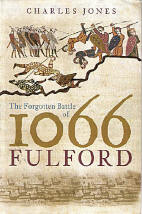All History Guide: Your guide to history on the Internet..
" .. this unusual, and yes, excellent history book.."
"More books like this one introducing historical study in a sympathetic was are needed.."
Now in paperback
... and into its 3rd reprint!
Analysis of map evidence
The collection of ancient maps in the York City library was examined. The plan was to see if the River Ouse had wandered from its course in the vicinity of modern Fulford. The maps, publication dates and some notes are tabulated below.
The topographic quality of the maps is variable. The purpose and market for the maps was evident from the features that were marked – Great Houses, Churches, tides or passable roads. Villages on the edge of a marsh were not seen as very important in this context so a limited amount of detail was available.
However, on some points the maps were consistent.
Course of the River Ouse
Of the 8 maps, all but one of the maps (Morden 1695), defines the distinctive bend in the river just beyond Fulford. Using this distinctive feature it appear that the river has flowed from York to Fulford following roughly the same line. There is certainly no evidence of a consistent variation.
Location of a drain or ditch near Fulford
Until the Plamer map in 1726 there is no marking of a ditch where Germany Beck now flows. This map show the tide tables along the River Ouse as far as the Humber. As it was designed for sailors the location of the 'river' in the location of Germany Beck is probably fairly accurate. It shows a bridge over the Beck. There are no other tributaries between Fulford and York.
Fulford place name
Using the sharp bend mentioned earlier it is possible to place Fulford reasonably accurately. The church at St Oswald’s is often marked providing another point of reference. The place name of Fulford wanders around and often vanishes. It is impossible to draw any conclusions for the location of the place names Gate Fulford, Water Fulford or Fulford itself.
The earliest map (Saxton 1577) shows Foule Sutton where modern Fulford is located. Fowl Sutton is still on the maps a century later. Foule Sutton is used through the 18th century. Sutton is an Anglo Saxon name for South farmstead. Bowan’s map of 1750 has concentric circles for the centre of York and shows Gate Fulford correctly located at a distance of 2 miles.
There is little point expecting to find 'contemporary' records referring to the name Fulford as this probably post-dates the battle. The descriptive nature of the name remains attractive. It is surprising that it is not more common as there must have been many swampy fords around the country.
|
Cartographer Or publisher |
Date |
Notes |
|
Saxton |
1577 & 1607 |
Foule Sutton. Shape of river along modern course |
|
John Speede |
1610 |
Fowles Sutton: Course similar to present. The reverse of the map has an interesting commentary |
|
John Blaey |
1645 |
Foule Sutton: River on present course But another version puts Middlethorpe on the East bank in place of any Fulford |
|
Robert Morden |
1695 |
Fowl Sutton with gate Fulford East of Heslington |
|
John Boulter |
1712 |
Foule Sutton: River on present course |
|
William Palmer |
1726 |
Tide map. Bridge over Beck besides Gate Fouldford. River on modern course |
|
E Bowan |
1750 |
Gate Fulford accurate positioned by distance from City. |
|
C Smith |
1804 |
Gate Pulford and Water Pulford in modern locations and Beck in modern position |


